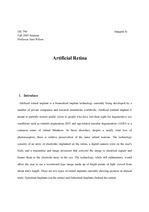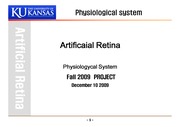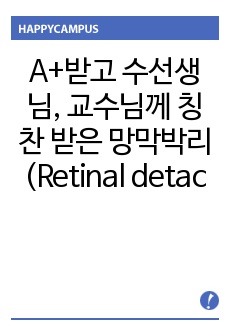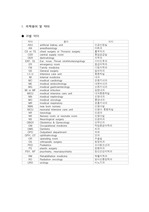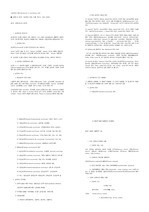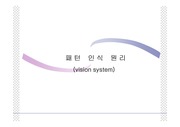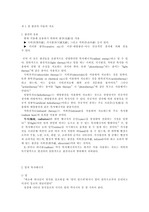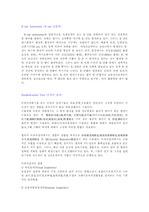

-
미리보기
소개
인공 망막에 대한 전반적인 자료 보고 (영문)
Report for artificial retinal implant목차
Artificial Retina
1. Introduce
2. Eye Anatomy and Physiology
3. Eye Disease
4. Retinal Prosthesis
5. Signal Transfer
6. Looking Forward
Reference본문내용
Artificial retinal implant is a biomedical implant technology currently being developed by a number of private companies and research institutions worldwide. Artificial rentinal implant is meant to partially restore useful vision to people who have lost their sight for degenerative eye conditions such as retinitis pigmentosa (RP) and age-related macular degeneration (AMD) is a common cause of retinal blindness. In these disorders, despite a nearly total loss of photoreceptors, there is relative preservation of the inner retinal neurons. The technology consists of an array of electrodes implanted on the retina, a digital camera worn on the user`s body, and a transmitter and image processor that
Looking Forward
The feasibility of a retinal prosthesis to restore vision is currently under investigation in 5 clinical trials. The 16-electrode epiretinal implant from Second Sight Medical Products, Inc, Sylmar, California, has been implanted long-term in 6 subjects in the United States for more than 5 years, and this is the only study with subjects using the full system in their homes. Intelligent Medical Implants GmbH, Bonn, Germany, described 4 subjects with an implanted 49-electrode epiretinal array in a trial designed to last 18 months. The EPI RET3 25-electrode epiretinal array was implanted for 4 weeks in 6 blind subjects. A subretinal implant composed of a 1550-microphotodiode array and a 4x4-electrode array from Retina Implant AG, Reutlingen참고자료
· 1. James D.Weiland, Wentai Liu and Mark S. Humayun Retinal Prosthesis. Annu. Rev. Biomed. Eng. 2005. 7:361-401.
· 2. Avi Caspi, Jessy D. Dorn, Kelly H. McClure, Mark S. Humayun, Robert J. Greenberg and Matthew J. McMahon Feasibility Study of a Retinal Prosthesis: Spatial Vision with a 16-Electrode implant. American Medical Association 2009. 127; 4:398-401.
· 3. Mokwa W. An Implantable Microsystem: As a Vision Prosthesis. Medical Device Technology 2007. 20-23.
· 4. Alan Y. Chow, Vincent Y. Chow, Kirk H. Packo, John S. Pollack, Gholam A. Peyman and Ronald Schuchard The Artificial Silicon Retina Microchip for the Treatment of Vision Loss From Retinitis Pigmentosa. American Medical Association 2004. 122; 460-469.
· 5. Viola M. V. and Patrinos A. A Neuroprosthesis for Restoring Sight. Acta neurochirurgica. 2007. 97; 481-486.
· 6. Ralf Hornig, Thomas Laube, PeterWalter, Michaela Velikay-Parel, Norbert Bornfeld, Matthias Feucht, Harun Akguel and Gernot R¨ossler A method and technical equipment for an acute human trial to evaluate retinal implant technology. JOURNAL OF NEURAL ENGINEERING. 2005. 2:S129-S134
· 7. Bron, A.J., Tripathi, R.C. and Tripathi, B.J. Wolff ’s Anatomy of the Eye and Orbit. London: Chapman & Hall. 8th ed. 1997.
· 8. Berson E.L. Retinitis pigmentosa. The Friedenwald Lecture. Invest. Ophthalmol. Vis. Sci.2003. 34; 5:1659–1676
· 9. Kim, S., Sadda S, Pearlman J, Humayun MS, de Juan E Jr, et al. Morphometric analysis of the macula in eyes with disciform age-related macular degeneration. Retina. 2002. 22; 4:471–477
· 10. Humayun MS,Weiland J, Fujii G, Greenberg RJ, Williamson R, et al. Visual perception in a blind subject with a chronic microelectronic retinal prosthesis. Vis. Res. 2003. 43; 24:2573–2581
· 11. Zrenner, E., Stett, A., Weiss, S., Aramant, R.B., Guenther, E., et al. Can subretinal microphotodiodes successfully replace degenerated photoreceptors?. Vis. Res. 1999. 39:2555–2567
· 12. Liu, W., Vichienchom, K., Clements, M., DeMarco, S.C., Hughes, C., McGucken, E., Humayun, M.S., De Juan E., Weiland, J.D. and Greenberg, R. A neuro-stimulus chip with telemetry unit for a retinal prosthetic device. IEEE J Solid State Circuits. 2000. 35: 1487–1497태그
-
자료후기
Ai 리뷰이 자료는 깊이 있는 내용과 함께 과제에 적용 가능한 내용이 많아 도움이 되었습니다. 과제에 바로 활용할 수 있어 매우 만족스러웠습니다. 감사합니다. -
자주묻는질문의 답변을 확인해 주세요

꼭 알아주세요
-
자료의 정보 및 내용의 진실성에 대하여 해피캠퍼스는 보증하지 않으며, 해당 정보 및 게시물 저작권과 기타 법적 책임은 자료 등록자에게 있습니다.
자료 및 게시물 내용의 불법적 이용, 무단 전재∙배포는 금지되어 있습니다.
저작권침해, 명예훼손 등 분쟁 요소 발견 시 고객센터의 저작권침해 신고센터를 이용해 주시기 바랍니다. -
해피캠퍼스는 구매자와 판매자 모두가 만족하는 서비스가 되도록 노력하고 있으며, 아래의 4가지 자료환불 조건을 꼭 확인해주시기 바랍니다.
파일오류 중복자료 저작권 없음 설명과 실제 내용 불일치 파일의 다운로드가 제대로 되지 않거나 파일형식에 맞는 프로그램으로 정상 작동하지 않는 경우 다른 자료와 70% 이상 내용이 일치하는 경우 (중복임을 확인할 수 있는 근거 필요함) 인터넷의 다른 사이트, 연구기관, 학교, 서적 등의 자료를 도용한 경우 자료의 설명과 실제 자료의 내용이 일치하지 않는 경우
함께 구매한 자료도 확인해 보세요!
-
[특허법]의료방법의 발명에 관한 특허법상 논점 7페이지
특허법이 의료방법을 특허대상에서 제외하고 이유는 다음과 같다. 첫째, 치료분야의 기술혁신을 담당하는 자는 지금까지 대학 등 공공기관이 중심이었고, 연구비의 공적 보조 등을 통해서 경제적 인센티브를 부여할 수 있으므로, 특허대상으로 할 필요는 없었다. 둘째, 연구의 인센티브는 경제적인 것보다도 새로운 치료방법을 발견한 것에 대한 학문적 평가 등.. -
의료발명과 특허 12페이지
-들어가면서- 최근 우리나라에서 있었던 황 우석 교수의 줄기세포 사건으로 국민적으로 특허에 대한 절차와 방법이 집중되었다. 인간배아 줄기세포에 관한 연구는 인간 생명 연장이라는 새로운 가능성을 제시하는 분야이며 또한 우리나라의 관련 기술이 선진국과 경쟁할 만한 분야로 생각되었다. 그래서 국가적으로 관련 기술을 보호하고 특허를 출원하려고 했지만 황우석 ..
찾으시던 자료가 아닌가요?
지금 보는 자료와 연관되어 있어요!
문서 초안을 생성해주는 EasyAI
